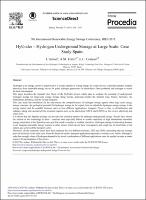Por favor, use este identificador para citar o enlazar este ítem:
https://repositorio.usj.es/handle/123456789/304
Registro completo de metadatos
| Campo DC | Valor | Lengua/Idioma |
|---|---|---|
| dc.contributor.author | Simón, Jesús | - |
| dc.contributor.author | Férriz, Ana María | - |
| dc.contributor.author | Correas, Luis Carlos | - |
| dc.date.accessioned | 2020-01-20T12:05:55Z | - |
| dc.date.available | 2020-01-20T12:05:55Z | - |
| dc.date.issued | 2015 | - |
| dc.identifier.citation | Simon, J., Ferriz, A. M., & Correas, L. C. (2015). HyUnder - hydrogen underground storage at large scale: Case study spain. Paper presented at the Energy Procedia, , 73 136-144. | es_ES |
| dc.identifier.issn | 18766102 | es_ES |
| dc.identifier.uri | https://repositorio.usj.es/handle/123456789/304 | - |
| dc.description | Hydrogen as an energy carrier is understood as a system capable of storing energy for a later use in a controlled manner. Surplus electricity from renewable energy serves for green hydrogen generation via electrolysis. Once produced, the hydrogen is stored for later consumption. This paper describes the Spanish Case Study of the HyUnder project which aims to evaluate the potential of underground hydrogen storage for large-scale energy storage along Europe, analysing besides the Spanish Case, France, Germany, the Netherlands, Romania, and the United Kingdom. This case study has considered for the assessment, the competitiveness of hydrogen storage against other large scale energy storage concepts, the geological potential for hydrogen storage in the region,how to embed the hydrogen energy storage in the energy market and the possible business cases in four differentapplications: transport, Power toGas, re-electrification and industry, taking into account all the economic aspects such us the electrolyser OPEXand CAPEXor the cavern, electricity and water costs. It is shown that the Spanish geology can provide four technicaloptions for hydrogen underground storage. Results have shown the interest of the technology in short –medium term especially linked to certain conditions of high intermittent renewable energy penetration in the Spanish power grid that result in surplus or residual electricity. Hydrogen storage is interesting because it can integrate renewable energy systems in other sectors which do not have overcapacity and a high use of fossil fuels as thenatural gas sector and the transport sector. Moreover, all the economic issues have been analysed for two different horizons, 2025 and 2050; concluding that the average price of electricity is the main cost. From the financial results, transport application represents a business case which, although in order has enough values of hydrogen demand to be stored, combination of different applications must be neededin order to make sense to the development of the cavern. | es_ES |
| dc.format.mimetype | application/pdf | es_ES |
| dc.language.iso | eng | es_ES |
| dc.publisher | Elsevier | es_ES |
| dc.relation | This work was supported by The Fuel Cell and Hydrogen Joint Undertaking, a public private partnership of the European Commission and industry, under Grant Agreement nº 303 417. | es_ES |
| dc.rights | Atribución 4.0 Internacional | * |
| dc.rights.uri | http://creativecommons.org/licenses/by/4.0/ | * |
| dc.subject | Almacenamiento subterráneo de hidrógeno a gran escala | es_ES |
| dc.subject | Power-to-Gas. | es_ES |
| dc.title | HyUnder - Hydrogen underground storage at large scale: Case study Spain | es_ES |
| dc.type | journal article | es_ES |
| dc.subject.unesco | Fuente de energía renovable | es_ES |
| dc.identifier.publicationfirstpage | 136 | es_ES |
| dc.identifier.publicationlastpage | 144 | es_ES |
| dc.identifier.doi | 10.1016/j.egypro.2015.07.661 | es_ES |
| dc.rights.accessRights | open access | es_ES |
| Aparece en las colecciones: | Artículos de revistas | |
Ficheros en este ítem:
| Fichero | Descripción | Tamaño | Formato | |
|---|---|---|---|---|
| HyUnder – Hydrogen Underground Storage at Large Scale.pdf | 827,49 kB | Adobe PDF |  Visualizar/Abrir |
Este ítem está sujeto a una licencia Creative Commons Licencia Creative Commons

